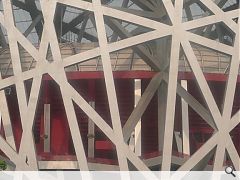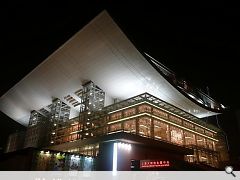China Rising
1 Apr 2011
The word ‘democracy’ can be a difficult one to pin down depending on which part of the world you apply it to. Most in the West would consider it to refer to a state of Government in which the people hold supreme power through representatives that they have elected. Hand in hand with this is a demonstrable sense of social equality. Even described in these terms, democracy can be a very abstract concept. For China as it gradually emerges from being a closed and relatively unknown environment to one engaging far more directly with the rest of the world, the issue may be less about democracy and more about personal liberty.
Prior to visiting the country for the first time in 2009, my preconceptions about the country were fed by the media. I assumed a determinedly introspective communistic place where individual rights and freedoms which I take for granted are denied. In 2011 people in China have much more liberty than their parents had in the 70s to love, work, shop, spend, enjoy, travel, speak, believe and fundamentally, to live. With China recently overtaking Japan, becoming the predominant new world order and the epicentre of worldwide economic growth, the basic form of liberty that is required to survive the contemporary Chinese urban life does exist for all her citizens. However it is becoming more evident that the extent of liberty is directly proportional to an individual's wealth and power. In that sense, the developing Chinese society may be far more recognisable to Western civilisation than the USA and its allies might be prepared to admit.If Capitalism is defined as an economic system based on private ownership of land, capital and the means of production, China is rapidly moving much closer to this model. But it is the issues surrounding ownership of land and personal advancement where the greatest anomalies still remain. By the end of the Cultural Revolution in 1976, virtually all land was state owned. Private property rights had all but disappeared and land transactions were illegal. Since China is still fundamentally Socialist in ideology, land remains mostly in government ownership. However, private developers can now purchase the rights to use the land. It’s a very interesting and subtle shift in approach born from a policy rooted in socialism which has created a ‘right of use culture’. As a result of this right, it has been granted to those developers who have money – a more recognisable shift from communism to capitalism. Nonetheless, other factors beyond differences in costs and land values are now becoming more important and it is in this key aspect that times must change for China. By paying a huge price in social and environmental terms, China has achieved a strange mix of concern for its ignorance of its people and their human rights, and envy for the uncompromising momentum of its development.
But this shift has also created unsustainable acceleration in the real estate market leading to what many refer to as the ‘Ghost Towns of China’. Built at breakneck speed in only five years, Kangbashi in Inner Mongolia is a state-of-the-art city full of architectural marvels and sculpture gardens. There's just one thing missing: people. The city stands as a physical representation of an obsession with GDP that makes no distinction between quantity and quality. Similarly, the massive Three Gorges Dam project is considered in China as an historic engineering, economic and social success. The Dam produces electricity, increases the Yangtze River’s shipping capacity and reduces the regularity of substantial flooding downstream by the creation of flood storage pockets. To achieve these things more than one and a quarter million people were evicted with allegations that the funds for relocating numerous farmers had ‘gone missing’ leaving them with no compensation. Of course, such examples can be very negative but the results of the government's planning control system can see complicated planning and development issues in China resolved very efficiently and quickly. They are developing one of the best infrastructures in the world with roadways and high speed rail networks that are propelling the internal economy, becoming universally admired and envied in the process.
For other countries trying (and failing) to keep pace with the growth of China’s relentless financial strength, the law, market regulation, the environment and most significantly, the human capital are all highly topical and significant issues. Many expect China to gradually adjust its economic structure and reduce its environmental impact. There are also some small, but nonetheless hopeful signs that as China’s leaders prepare for retirement in 2012 they will no longer be seeking growth at any cost. In President Hu Jintao’s summary, growth must serve a ‘harmonious society’. Harmony in this instance equates with a narrowing of the poverty gap between countryside and city, and more generally that the poorer inland regions catch up with the coastal ones.
It is these very complex contradictions inherent in China’s rapid development which makes it such a fascinating place for architects to work. The search for an architectural identity in an era of increasing globalisation is a relatively universal one and not simply restricted to China. However there is a clear dilemma inherent in how its built environment develops against this backdrop.Chinese culture is recognised as one of the oldest and richest in the world. Many elements of old China – Buddhism, Taoism and Confucianism – still play an important role today in the society. They are considered not only to be the standard for what is actually Chinese, but they serve to demarcate against cultural imports from other parts of the world. The result of this is unsurprisingly a point of view orientated on the past. On the other hand, the economic boom and the nation reacting to global mechanisms have also created the desire for a new China, partly detached from the old, more restrictive traditions.
This dichotomy has manifested itself in the higher profile architecture promoted by some exceptional international practices receiving significant criticism. Paul Andreu’s Beijing Opera House is seen as being too non-Chinese and not well enough adapted to its context. Moreover, too much steel has been used rendering the project more expensive than it perhaps needed to be. Rem Koolhaas has faced similarly unfair criticism for his CCTV-Tower and even the celebrated Olympic Stadium by Herzog & de Meuron has suffered from the media accusations of foreign architects not understanding Chinese culture and arrogantly ignoring the needs of the Chinese people.
The difficulties of drawing direct references from native Chinese architectural history are obvious. The attempts at making these references have produced conflicting results on our original proposal for the Huangshan Theatre. The superficial appropriation of traditional stylistic elements may convince people in China that a building is Chinese and that it corresponds to their culture. An architectural aesthetic based on metal roofs and steel-glass facades is still considered foreign, even though it amounts to the majority of new building activity in China. People are aware that this form of architecture is imported yet they will still look for signals that the symbols of ancient China are being acknowledged.
Our influences for the Theatre’s concept were initially European. We were particularly interested in the qualities of Jean Nouvel’s Concert Hall in Copenhagen which attempts to use a very simple geometry to set its own context. But we were also struck by the Library of Wenzheng College, Suzhou by the Amateur Architecture Studio and the Performing Arts Centre of Datang Everbright Town in Xi’an by Xiang Bingren and Chen Qaing. Both of these latter projects are a clever mix of Chinese pavilion architecture and a defined modernism. The simple form and a logical arrangement of spaces support the clarity and precision of the architectural language. That both of these practices are from the new generation of young Chinese architects who have for the most part studied abroad is significant. They have absorbed influences from other parts of the world and have applied a very subtle approach to regional characteristics with a robust sense of functionality to define their approach.
Another key difference demarcating China from the West is the prevalence of a culture of discussion. Terms in commercial contracts are usually not as explicitly spelt out or detailed as we would expect in the west. As a result, discrepancies and differences between various parties are usually resolved by negotiation with each party roughly following the ‘rules’ as stated in the contract. Very often the results of these discussions hinge on the relationship (or ‘guan xi’) of the key people involved. In a western society, contracts are often carried out irrespective of individuals but strictly following the agreed stated terms. Such a significant cultural difference is the main reason for the often complex and non-descriptive nature of statutory procedures, when issues will be resolved as a project is ‘progressed along’, as ‘seeking common ground whilst maintaining differences’ is the key to the spirit of a typically Chinese way of handling various issues.
At a time when UK based architects are immersed in the difficulties of drastic and unsustainable lowest cost fee bidding for reducing public sector programmes of work and the opportunities in more commercial circles remain tentative at best, the opportunities in China for practices such as Keppie seem really attractive. Every second, third and fourth tier town or city has a 20 or 30 year vision plan which it has only recently developed, usually in anticipation of the positive impact of the MAGLEV network in connecting various regions. Many of these plans are outlined in zonal aspiration but understandably lack the detail by which one can fully evaluate their ambition. Working with Local Design Institutes, we see a future full of potential where new ideas about sustainable and stimulating design are beginning to be cautiously welcomed, and where the richly poetic symbolism of the past still has a significant role to play in the development of the future.
David Ross; design director, Keppie
|
|





